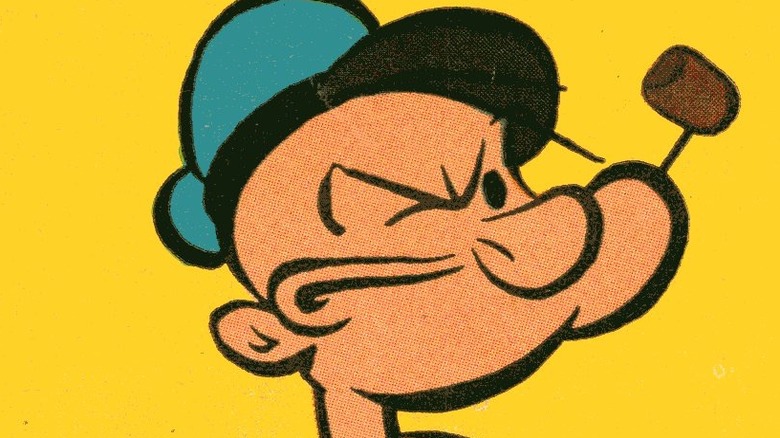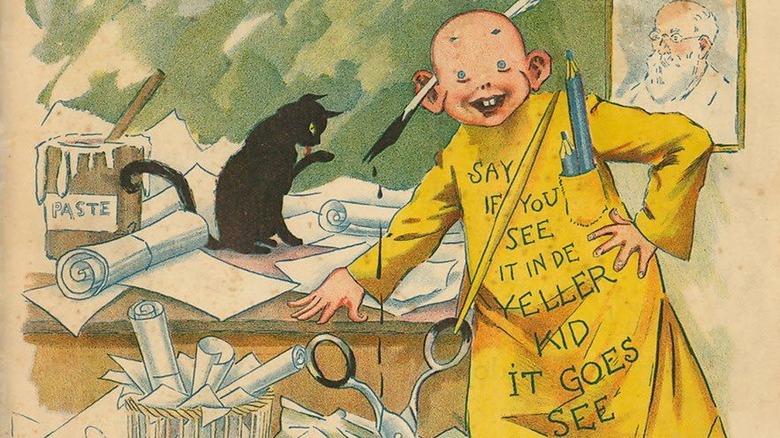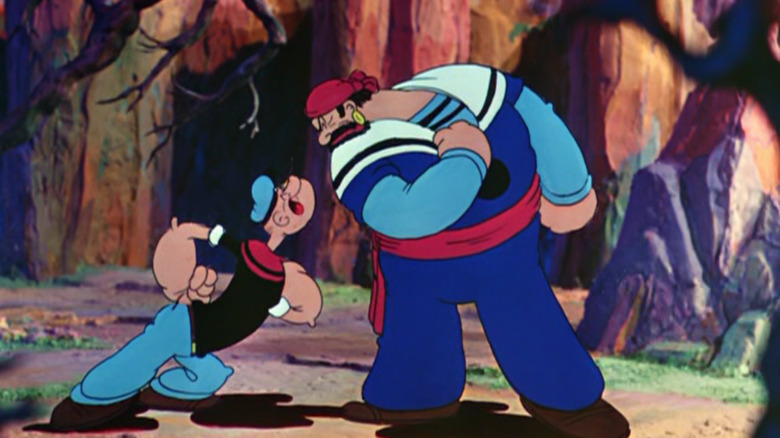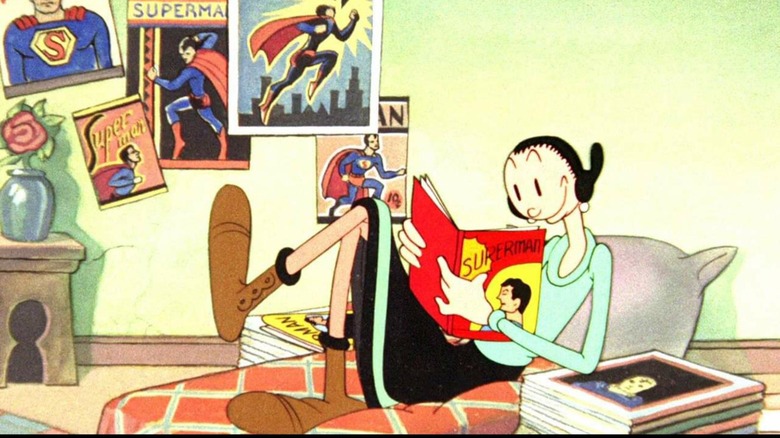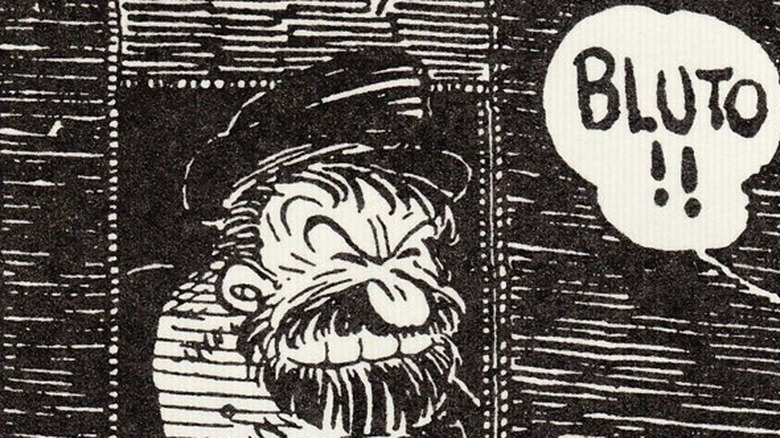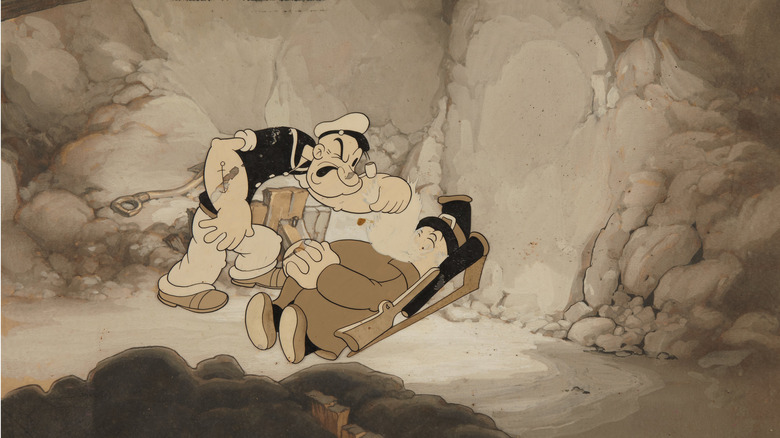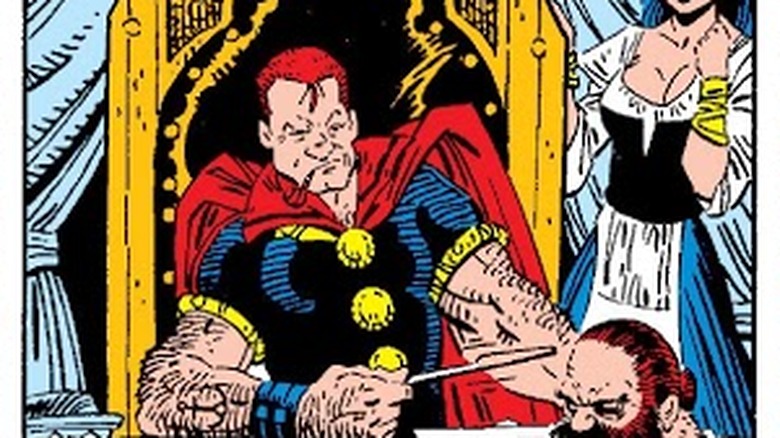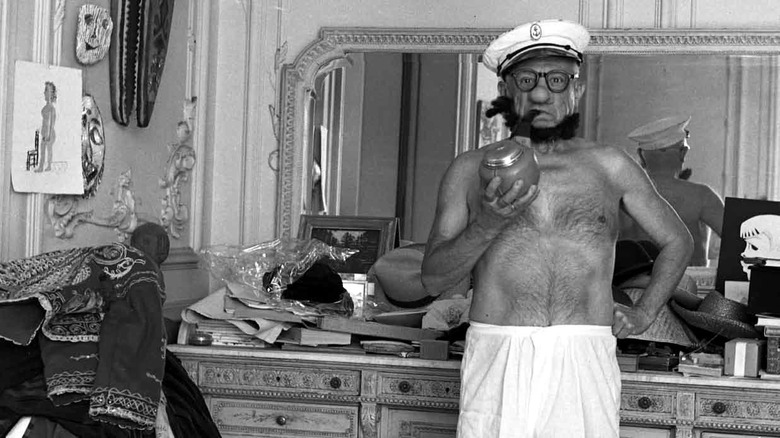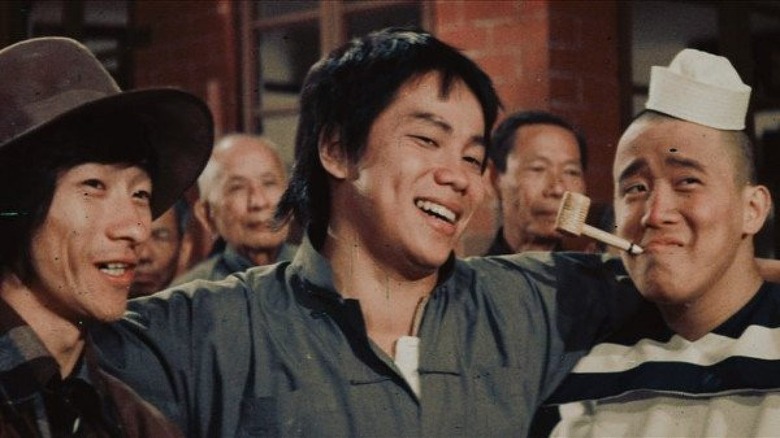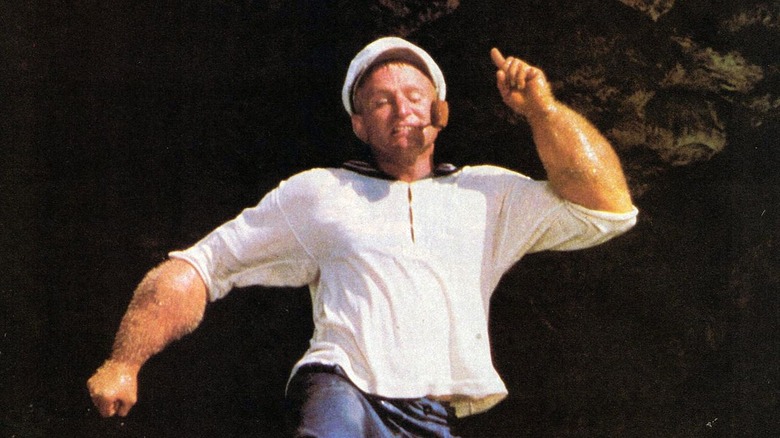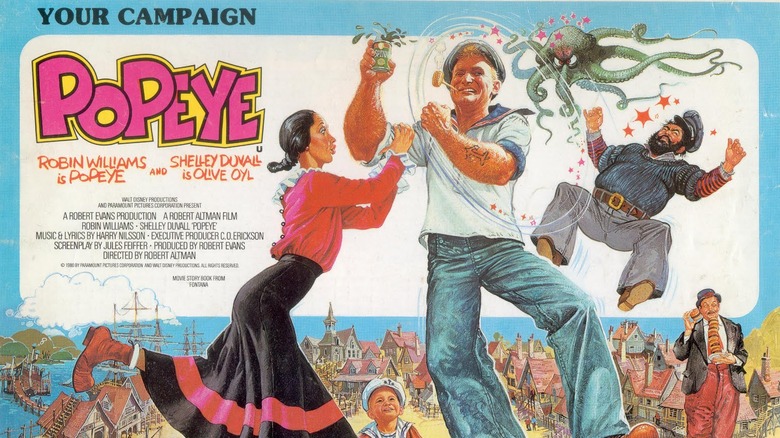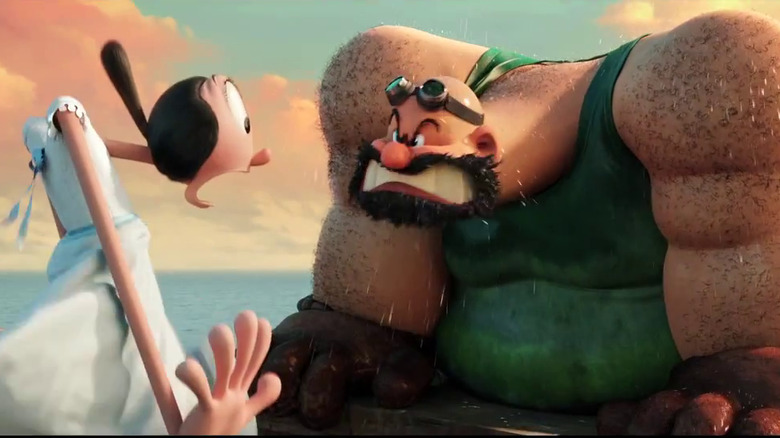The Untold Truth Of Popeye
He's Popeye the Sailor Man. He's Popeye the Sailor Man. We know he fights to the finish because he eats his spinach, but how much do we really know about one of the most iconic characters of 20th-century fiction?
Most likely, it's been a long time since you saw a "Popeye" cartoon filling airtime on TV or caught the Robert Altman movie on cable, but you can probably recite his catchphrases just the same. He's nowhere near as popular as he was at the height of his fame— but at this point, he has transcended popularity. He's a part of American folklore, as inescapable as Uncle Sam or Santa Claus.
Popeye's many incarnations over the years are worth seeking out, not only to enjoy the evolution of an icon, but also to learn more about the various periods in which they were produced. The classic Paramount cartoons from the Fleischer Brothers are full of manic energy, the original comics by E.C. Segar that inspired them are even better — and that's just the tip of the corncob pipe. Popeye, like any old sea salt worth his salt, has plenty of tall stories to tell. Here are just a few of them.
Popeye's creator got the job thanks to the father of American comics
Before he ever lit up a movie or TV screen, Popeye appeared as a side character in E.C. Segar's "Thimble Theater" newspaper comics. The series had gone on for almost a decade before he appeared, chronicling the adventures of Popeye's future "sweet patootie" Olive Oyl, along with her brother Castor and boyfriend Ham Gravy. Popeye only appeared because they needed an experienced hand to get them across the ocean, but readers knew an icon when they saw one and demanded more. Soon, Ham and Castor were out and Popeye was in, and "Thimble Theater" became more popular and better than ever.
According to Lambiek Comiclopedia, it might never have happened if Segar hadn't attracted the attention of the godfather of the comics world. You can argue for hours about who invented the comics (and it'll depend a lot on how you define "comics"), but pretty much everyone agrees the American newspaper comic was the work of R.F. Outcault.
In the 1890s, Outcault debuted "The Yellow Kid" with the adventures of children living in Hogan's Alley, including a little boy in a yellow nightshirt. The feature's popularity led rival papers into an arms race to debut their own comics, and Outcault himself created another icon in 1902 with "Buster Brown." Many years later, he met a struggling young cartoonist named E.C. Segar and got him a job at the Chicago Herald illustrating the adventures of another comedy legend — Charlie Chaplin.
The classic Popeye cartoons used a revolutionary 3D process
The "Popeye" comics were so popular that the big screen was the logical next stop. The sailor found just the team to bring him there in the Fleischer Brothers, who had already created the classic "Betty Boop" series and would follow it up with the first animated "Superman."
They introduced Popeye to moviegoers in 1933 in a crossover with Betty, and they'd continue animating his adventures until the studio shuttered in 1942 and their bosses at Paramount handed off the Sailor Man to the new Famous Studios.
Animation technology has come a long way since then, but there's still a lot in those old cartoons to amaze modern viewers. That's especially true in scenes where Popeye wanders through vividly realistic 3D landscapes at a time when the words "computer animation" would get you a blank stare. So, how did they do that?
The answer's about as simple as you could hope for: Those backgrounds really are 3D. As Fleischer biographer Ray Pointer explains, the studio used what they called a "setback" camera to take the transparent cels the characters were painted on and lay them vertically in front of a sculpted background instead of horizontally on a flat painting. This allowed the camera to move in three dimensions, and the animators to use studio lights for realistic day and night scenes. Amazingly, they did all this years before Disney got much more publicity for their own 3D process, the multiplane camera.
Of course, they also did it about 60 years before "Toy Story" would make computer animation a household term.
Olive Oyl's voice filled in as Popeye
Even if you've never seen one of these cartoons, you've probably got a good idea what they sound like. The cast, including Jack Mercer as Popeye and Mae Questel as Olive Oyl, have burned their distinctive voices into the background radiation of pop culture.
But Olive is far from the only iconic role Questel played in her long career. As the voice of Betty Boop (a character also based on her appearance), she was already Fleischer's top star before they got the "Popeye" contract, and she'd continue playing both characters the rest of her life. You may have also seen her in front of the camera in the musical classic "Funny Girl," or in her final roles as Woody Allen's mother in "New York Stories" and Chevy Chase's aunt Bethany in "National Lampoon's Christmas Vacation."
On a 1978 talk show appearance, Questel said she based Olive's voice on the always-flustered Zasu Pitts. "I saw a storyboard and nearly fainted. Look at that face, and the legs and the whole bit," she recalled. "Max Fleischer said to me, 'Mae, what kind of voice should she have?' At the time, I did dogs, cats, you name it."
There's one other iconic role in her resumé you might not expect. In "Of Mice and Magic," Leonard Maltin writes about how Mercer's bosses at Famous Studios got around his absence when he was serving in World War II by saving up backlogs of scripts for him to record whenever he got a furlough. But that wasn't always enough, so they did some creative reshuffling and had Questel play both Popeye and Olive in a couple of shorts.
"We had a Popeye all set up, right at the recording studio. This man had been on the stage; he had the know-how and he had the voice. But he got mic fright," Questel recalled of those cartoons. "Here we are at the RCA studios, trying to get through, so I stepped in. And of course, the engineer did a little engineering, but I sounded like 'Woah, blow me down!'"
King Features forgot whether they owned Bluto
Three characters have primarily made up the center of the "Popeye" universe: Popeye, Olive, and Bluto. So, it can be a little jarring to pick up the original comics and not see the big bearded bully.
Segar only drew him once, in 1932 (not coincidentally, a year before the animated series started). Even there, he's a very different character from the cartoons — Segar's "Bluto the Terrible" was a dreaded pirate who even Popeye was afraid of, and it took the one-eyed sailor two weeks of nonstop fighting to finally knock him out.
That was the last time Segar used Bluto — but thanks to the cartoons, he would soon become an inseparable part of the Popeye story.
By the time King Features went to work producing their own "Popeye" cartoons for TV in the '60s, Bluto had been an integral part of the success of the 1933-1957 Fleischer cartoons, and had to be in there. But since he'd disappeared from the comics for so long (and Google searches were decades away, King's research team assumed he had never been in the Segar comics and was an original Paramount creation.
Fearing a copyright lawsuit, the solution was about as lazy as you'd expect from a company that couldn't be bothered to learn the history of their own comics — they created a "new" character named Brutus whose distinction from Bluto begins and ends with moving a couple letters around. They even brought back Jackson Beck, who'd been playing Bluto since the '30s, to do the voice.
Ensuing writers of the cartoon had a lot of fun with the confusion, eventually revealing they were brothers and — in one story from Hy Eisman — sending them out to tag team Popeye.
The Marvel Universe's co-creator got his start on Popeye
With his superhuman strength, you could call Popeye the first comics superhero, and he has a surprising connection to some of the most popular superheroes out there. Jack Kirby, a titan of the industry who had a hand in the creation of so many popular superheroes, from the X-Men to the Avengers to the New Gods — had a direct involvement in Popeye's adventures as well.
Born Jacob Kurtzberg to a family of Jewish-Austrian immigrants in New York, Jack Kirby scoped out an artistic career from a young age. Before he teamed with Stan Lee to create iconic Marvel heroes like Hulk, Thor, Iron Man and Black Panther, Kirby paid his dues at the Fleischer Brothers studio as an in-betweener — an assistant animator hired to add intermediate drawings, smoothing out the movements of Popeye and other characters. Working on these classic cartoons might sound like a dream job, but keep in mind back in those days, a few seconds of animation would necessitate endless repetition of the same picture again and again with tiny movements.
It was a nightmare for the man who would come to be called "King" Kirby. He said in 1971: "My father worked in a factory with long rows of tables with sewing machines on them ... that's what I was doing at Fleischer's ... they were manufacturing pictures."
He got out as soon as he could and into comics — including, ironically, a Popeye take-off called "Socko the Sea Dog." But you can see the effects of that experience in Kirby's later work. His negative experience as a cog in the cartoon machine may have solidified the artistic integrity and individualism that made Kirby's comics so great — and often, his career so difficult.
Popeye snuck into the Marvel Universe
As it turns out, Kirby is far from Popeye's only connection to the Marvel Universe. One of the publisher's most prolific inkers throughout the '70s and '80s was Terry Austin.
A huge "Popeye" fan, Austin enjoyed sneaking the sailor into his books —over at CBR, Brian Cronin has gone to work cataloging all the ways. In the special Alice Cooper story from "Marvel Premiere" #50, for instance, the shock rocker is committed to a mental hospital where Dr. Wimpy is holding "Group Therapy for the Punch Drunk" with Popeye and Bluto.
Popeye got a speaking role with some help from penciller Art Adams in "New Mutants Special Edition," as an Asgardian lord with a suspiciously Bluto-esque underling. The old sea dog also appeared on the other side of the universe during the legendary "X-Men: Dark Phoenix" storyline in #125. And if that wasn't a far enough voyage for a one-eyed sailor, Austin drew him into a different comic-book universe entirely for the equally legendary Batman storyline "The Laughing Fish" in "Detective Comics" #475.
Picasso posed as Popeye
Some of Popeye's biggest fans are just as famous as he is.
Pablo Picasso was synonymous with fine art, thanks to his revolutionary work from the beginning of the 20th century onward, inspiring hundreds of abstract and Cubist artists. In other words, Picasso was taken very seriously in the art world — but that doesn't mean he didn't have a sense of humor about himself.
One famous photo of the artist was taken in 1957 by French photographer André Villers. Villers discovered photography during a long hospital stay for tuberculosis, later met Picasso on the French Riviera, and spent the next decade with the legendary painter as his collaborator and subject. Picasso was excited by the artistic possibilities of photography, but he also enjoyed simply playing around with it.
The Age reveals the origin of Picasso's Popeye portrait: "As Picasso relaxed, however, he began to interact much more and would even play dress-ups, finding a hat or something odd to wear and ask to be photographed like that. [Villers says,] 'He said one day, 'Look at me, I am Popeye!'"
Popeye met Bruce Lee
"They're the Godfather's private bodyguards! One is James Bond and the other's Clint Eastwood!"
Sometimes, dialogue isn't supposed to seem logical. Bruce Lee's work in films like "Enter the Dragon" and series like "The Green Hornet" made him a global phenomenon, but he didn't live long enough to reap the rewards. So, after his passing, other filmmakers cashed in for him with a whole genre of "Brucesploitation" movies starring actors with names like Bruce Le, Bruce Li, and Bruce Leong in movies with names like "Enter Another Dragon" and "Enter the Fat Dragon."
1977's "The Dragon Lives Again" starred Leong as "Bruce Lee," depicted as waking up in hell. He decides to open a gym (as one is wont to do after learning of their eternal damnation), only to learn the evil people in hell are attempting a takeover of the underworld — and deciding he needs to stop it.
Of course, Leong looks nothing like Lee, and the audience is given a half-hearted explanation — one character explains, "It just so happens that when somebody dies their face and their body undergo a change." The filmmakers apparently decided that as long as they were pissing off Lee's surviving family it didn't matter if every copyright holder in the world was after them too — because other characters in hell include Dracula, the Godfather, the Exorcist, James Bond, Clint Eastwood and, yes, Popeye.
What follows is a whole lot of incoherent plot, sleazy sex, and some surprisingly solid action scenes. Even Popeye gets in on it, complete with the obligatory scene of him reaching for his spinach and the classic theme song — albeit, not many of those classic cartoons featured kung fu masters in skeleton leotards.
Director Robert Altman built a whole town to film Popeye
By 1980, comics-based movies were beginning to show they could make money: "Superman" and "Superman II" were tearing up the box office, and the Broadway smash "Annie" was the subject of an intense bidding war. According to "Fiasco" by James Robert Parish, Paramount producer Robert Evans lost out on the rights, so he looked to the funny pages for another likely musical star and settled on Popeye. Evans had been a major player in the "New Hollywood" movement of the '60s and '70s, propelling iconoclastic young directors like Francis Ford Coppola and Hal Ashby to stardom.
With that in mind, his unorthodox choice to direct "Popeye" was very on-brand — but few others thought it made any sense. Robert Altman was not the man you'd go to for cartoon spectacle. He was more interested in small-scale, dialogue-driven movies like "Nashville" and "3 Women."
As it would turn out, his style of improv-heavy, overlapping dialogue dovetailed nicely with the under-their-breath ad-libs of the Fleischer shorts. Besides, Altman had overseen large undertakings before. While most movies only build as much set as shows up on camera, for his western "McCabe and Mrs. Miller," Altman dramatized the building of a new town by actually building it right there on camera. He did the same for "Popeye" with the fishing village of Sweethaven. Altman chose Malta for his location — according to Parish, because it made it harder for his producers to reach him if they didn't like his methods. It turned out to be a wise investment — forty years later, Popeye Village is still a popular tourist attraction.
Popeye's oversized arms were a health hazard for Robin Williams
"Popeye" was the film debut of Robin Williams, hot off the success of "Mork and Mindy" and with "Aladdin," "Dead Poets' Society," and all the rest still ahead of him. It only makes sense that a living cartoon character would be the perfect choice to play a literal cartoon.
"I thought, this is it," Williams said. "This is my 'Superman,' and it's going to go through the f***ing roof! I also had the dream of getting up and thanking the Academy, but I got beyond the 'this-is-it' stage as soon as we started shooting. After the first day on 'Popeye,' I thought, 'Well, maybe this isn't it,' and I finally wound up going, 'Oh God, when is this going to be over?'" Even the infamous Evans/Altman recreational activities weren't enough to help him unwind — instead, he'd go inland to perform in Maltese bars.
The prosthetics Williams needed to wear for Popeye's iconic meaty forearms certainly didn't help any. At first, the crew created lightweight inflatable "muskles," but they neither looked nor worked right. Altman shot around Williams' arms while they waited for replacements to come in from Italy. The rubber/plastic arms looked fine, but they were murder on Williams. They cut off all circulation to his arms, and shooting would have to stop every time he went numb until he could get the blood flowing again.
The Popeye set narrowly avoided a major drug bust
Thanks in large part to Robert Evans, the '70s are remembered as the "sex, drugs and rock 'n' roll" era of American filmmaking — and even on a family-friendly Disney coproduction, that culture was alive and well. We don't know how much sex or rock 'n' roll went on in Sweetwater, but we do know that drugs almost sank the whole project.
Evans was making a trip to check his employees' progress when some of his baggage got lost en route. This would be annoying enough at the best of times, but the bag in question was full of contraband drugs for Evans and the "Popeye" crew that was presumably something a little stronger than spinach.
In his autobiography "The Kid Stays in the Picture," Evans wrote, "I wouldn't have been worried if my name hadn't been on the tags." He also claimed to have narrowly escaped the electric chair through a personal audience with Maltese Prime Minister Dominic Mintoff, telling him the missing bags contained a personal letter to Mintoff from then-US Secretary of State Henry Kissinger. Mintoff mustered all the country's resources to find Evans' bag, and the producer fled the country before they could discover what was actually inside.
The creator of Samurai Jack is bringing Popeye back
In the 21st century, Popeye is no longer the multimedia phenomenon he was in his heyday.
He has made a few memorable recent appearances, including a music video with college rock superstars Wilco, a brilliant but sadly short-lived comic revival from Roger Langridge, and a series of new comics by Langridge, "Squirrel Girl" artist Erica Henderson, and others to celebrate the sailor man's 90th anniversary. But a big-screen revival has been in the works for years, with no less of a talent than Genndy Tartakovsky behind it. He's shown he can do it all — from the maximalist cartoon silliness of "Dexter's Laboratory" and the "Hotel Transylvania" series to the minimalist, atmospheric classics "Samurai Jack," "Primal," and "Star Wars: Clone Wars" to an impressive run of "Luke Cage" comics.
An enticing test reel surfaced in 2014 along with an introduction from Tartakovsky, revealing why the project was so personal to him: "When I first started animation, my very first teacher was a 90-year-old 'Popeye' animator from the Fleischer studios, Gordon Sheehan." But then the project, like so much of the treasure Popeye has hunted for, sunk without a trace. Tartakovsky told Moviefone (via Animation Magazine) a year later that he'd left over creative differences to pursue an all-original project. But the project came back to life in 2020, when Slash Film reported he'd be returning. We'll see what comes of these rumors, but if it ever sees the light of day, here's hoping the results will make the sailor man's legacy proud.
